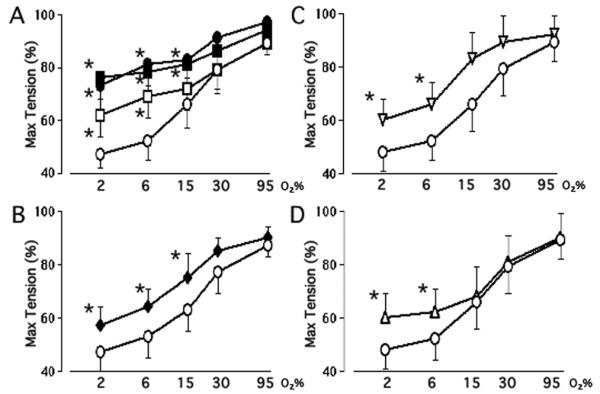Figure 4.

Effects of oxygen and K+-channel inhibitors in the Mature and Immature ductus arteriosus. Values represent ductus tension (mean±SD) (at a particular oxygen concentration) expressed as a percent of the net active tension produced by K+-Krebs solution at that particular oxygen concentration (Max Tension). Panel A: Ductus from mature (n=7) and immature (n=9) fetuses were studied in the presence or absence of 4AP/TEA/glibenclamide (Glib). Tensions in immature ductus, under Control (◯) conditions (at 2 and 6% O2) differed significantly (p<0.05) from tensions in mature ductus under Control (◻) conditions; the tensions at higher oxygen concentrations (15, 30 and 95% O2) were not significantly different between the immature and mature ductus under Control conditions. When the rings were incubated in 4AP/TEA/glibenclamide, immature ductus (●) developed the same tensions as mature ductus (∎). Panel B: Immature ductus were studied in the absence (◯) or presence (◆) of 4AP (n=7); Panel C: Immature ductus were studied in the absence (◯) or presence (◆) of iberiotoxin (n=6); Panel D: Immature ductus were studied in the absence (◯) or presence (▵) of glibenclamide (Glib, n=6). * p<0.05, experimental condition versus Immature Control. Ductus tension at 6, 15, 30 and 95% O2 differed significantly (p<0.05) from the tension at 2% O2, except for rings incubated in 4AP/TEA/glibenclamide, where tensions at 6% O2 were not significantly different from those at 2% O2.
